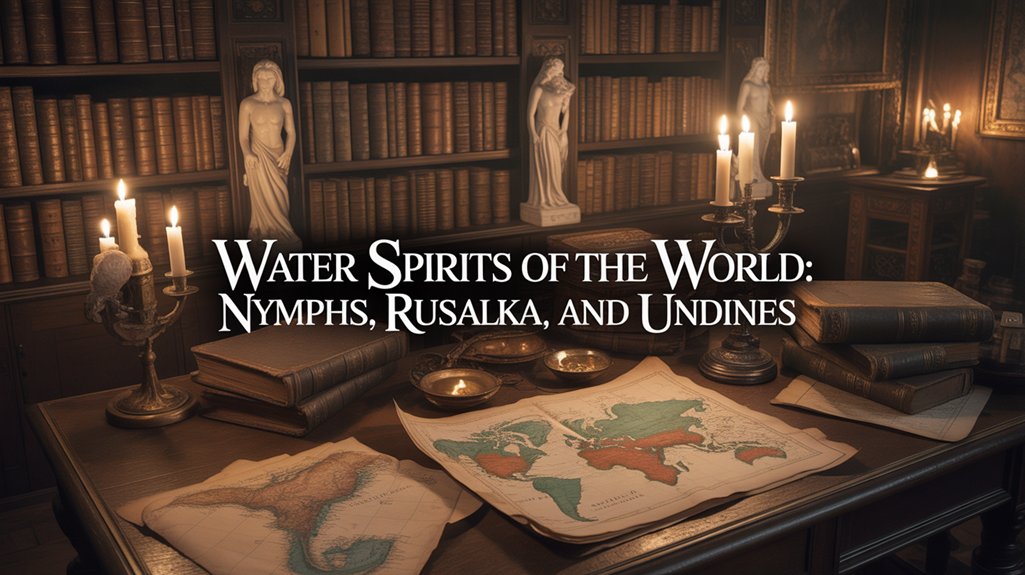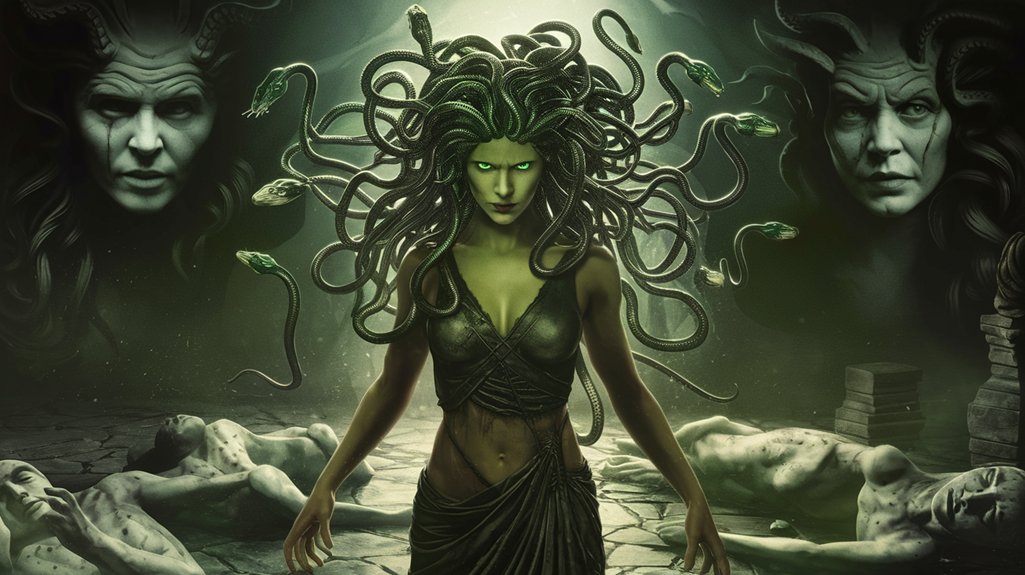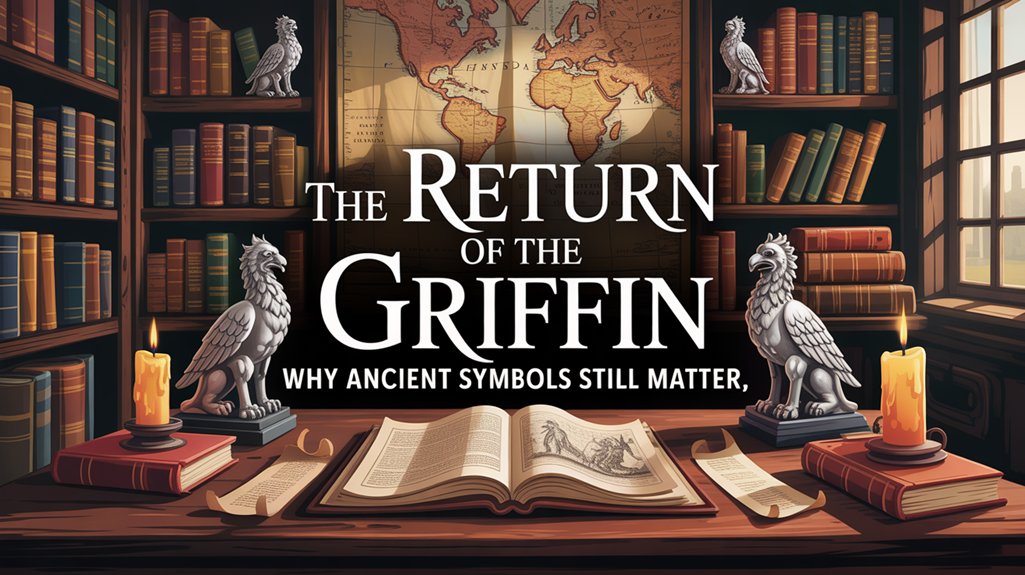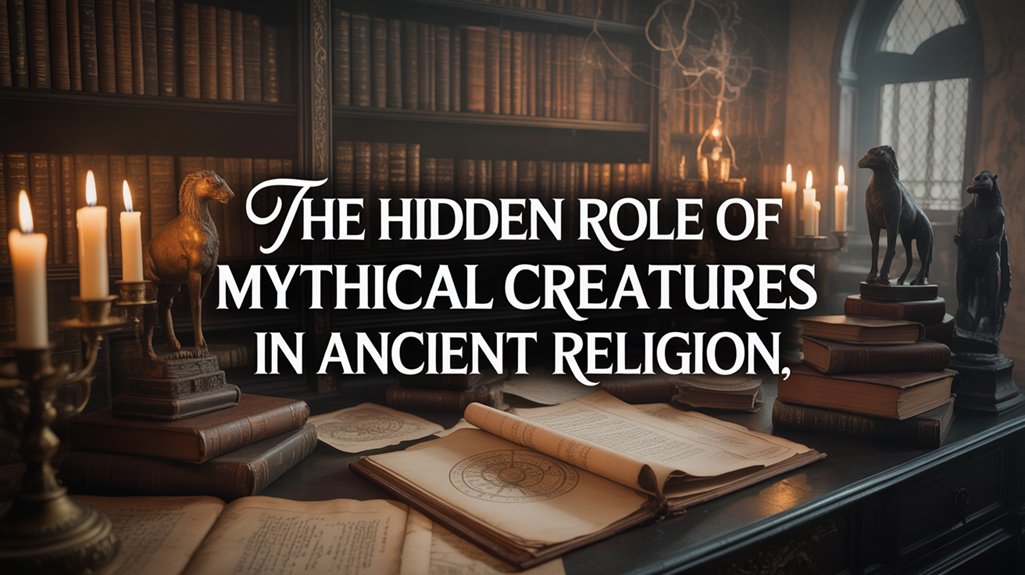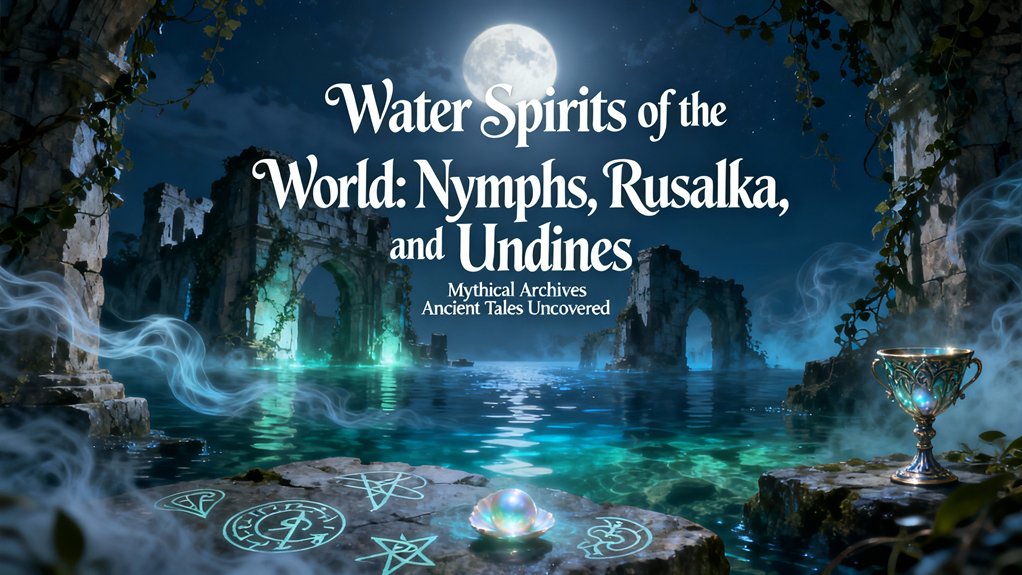
You’ll find water spirits emerging across disparate geographies—Mediterranean nymphs traced to Minoan worship since 1500 BCE, Slavic rusalki with their corpse-pale luminescence haunting northern waterways, and Renaissance undines embodying water’s protean essence itself. These entities share luminescent skin and unfathomable eyes yet diverge dramatically: Greek nymphs possess preternatural grace, rusalki extend elongated limbs toward drowning victims, undines shift between forms entirely. Each tradition independently developed beings that seduce, protect, and exact revenge, their powers including tidal control and granting immortality—ancient explanations for water’s dual nature that contemporary art alters into environmental commentary.
Table of Contents
ToggleKey Takeaways
- Water spirits originated independently across cultures: Mediterranean nymphs from Minoan worship, Slavic rusalki in northern waterways, and undines in Germanic traditions.
- Physical traits include luminescent skin and flowing hair, with rusalki appearing corpse-pale while undines shift between fluid forms.
- These spirits seduce mortals to watery deaths, protect fishermen who offer tribute, and exact revenge for pollution or broken vows.
- Cultural rituals include Rusal’naia ceremonies with woven wreaths, protective wormwood barriers, and collective dances mimicking rusalki movements.
- Artistic representations evolved from Renaissance marble fountains to Romantic literature, Pre-Raphaelite paintings, and contemporary environmental activism installations.
Ancient Greek Nymphs: Naiads, Nereids, and Oceanids
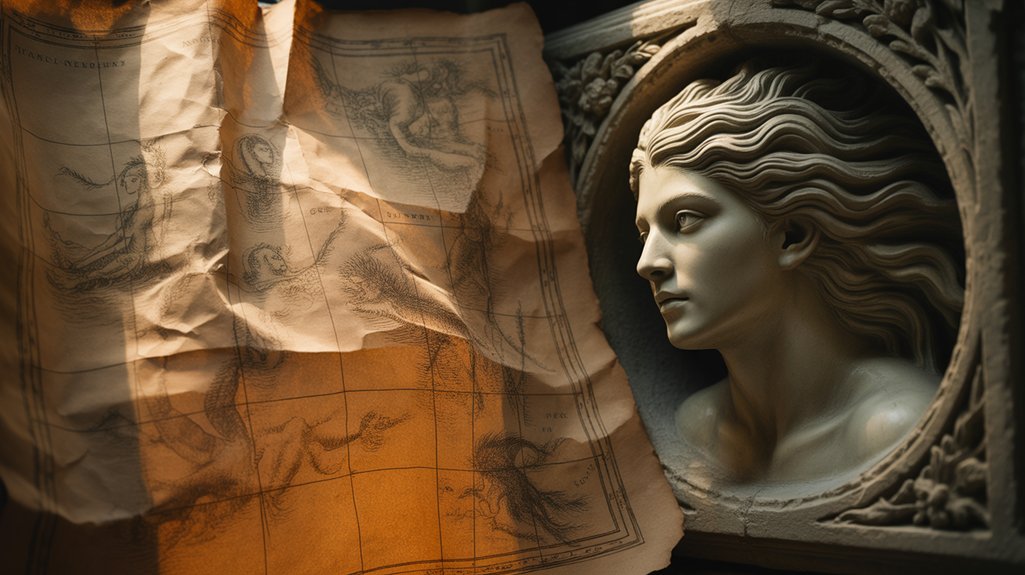
Within the crystalline depths of ancient Hellenic cosmology, water nymphs occupied a sacred triad of divine classification, each order bound to specific aquatic domains through genealogical descent and elemental affinity.
🎯 Recommended Products
Handpicked items related to this article:
As an Amazon Associate, we earn from qualifying purchases.
You’ll discover Naiads—those eldritch guardians of freshwater springs, rivers, and wells—whose Naiad habitats became shrines where mortals sought prophetic wisdom. Their power waxed and waned with seasonal floods.
Nereids, fifty daughters of Nereus, embodied the Mediterranean’s mercurial temperament; Nereid characteristics included shape-shifting abilities and benevolent protection of sailors steering through perilous currents. They danced upon foam-crested waves.
The Oceanids numbered three thousand, born from primordial Oceanus himself—Oceanid myths speak of cosmic boundaries where fresh and salt waters merged. These eldest sisters governed everything from clouds to underground streams, their Water symbolism representing the generative, life-sustaining force pervading existence.
Each classification reflected humanity’s understanding of water’s chimeric nature: nurturing yet destructive, transparent yet unfathomable.
The Tragic Rusalka of Slavic Folklore
You’ll encounter in Slavic folklore the rusalka, an eldritch maiden whose genesis lies neither in divine pantheon nor natural order but in tragedy—unbaptized children, drowned maidens, women who perished by their own hand in rivers and lakes across Russia, Ukraine, Poland, and the broader Slavonic territories.
These liminal beings, altered through violent death into something neither wholly spirit nor wholly corporeal, emerged from pre-Christian beliefs that endured through centuries of Orthodox conversion, their presence documented in ethnographic records from the eighteenth and nineteenth centuries alongside persistent village testimonies.
Communities developed intricate apotropaic practices—warding rituals during Rusalka Week (Rusal’naia nedelia) in early summer, offerings of cloth and flowers, protective incantations—recognizing these water spirits as dangerous intermediaries who inhabited the threshold between mortality and the otherworld, capable of luring men to watery graves or blessing crops with their nocturnal dances.
Origins of Rusalka Myths
Deep within the pre-Christian waterways of Eastern Europe, between the 9th and 12th centuries, the rusalka emerged from a confluence of Slavic animistic beliefs and Byzantine Orthodox interpretations of untimely death—a synthesis born from tragedy rather than divine conception.
Rusalka symbolism evolved through specific cultural catalysts:
- Unbaptized infants and murdered maidens altered into liminal beings
- Agrarian societies explaining drowning deaths through supernatural agency
- Pre-Christian water deities merged with Christian damnation narratives
- Seasonal festivals (Rusalka Week) marking dangerous spring floods
- Folklore variations spanning Polish topielice to Ukrainian mavky
These eldritch figures embodied freedom denied—souls trapped between worlds, neither living nor properly dead.
Each region crafted its chimeric interpretation, yet all shared one elemental truth: water remembers what land forgets.
Death and Transformation Tales
The change from maiden to rusalka follows prescribed patterns of catastrophe—betrayal, drowning, and alteration forming an unholy trinity across Slavic oral traditions. You’ll discover alteration myths demanding specific conditions: unmarried women meeting watery graves, their spirits refusing Christian burial rites. These death rituals shape eldritch beings bound to riverbanks.
| Catalyst | Alteration Method | Resulting Powers |
|---|---|---|
| Betrayed bride | Drowning at dawn | Voice enchantment |
| Suicide by river | Seven days submerged | Shape-shifting |
| Murdered maiden | Moonlit immersion | Memory manipulation |
| Unwed mother | Storm drowning | Dream invasion |
| Broken oath | Winter ice death | Weather control |
The chimeric nature of rusalki reflects your ancestral understanding: death births something neither wholly spectral nor corporeal. Freedom from mortal constraints. Terrible autonomy.
Cultural Rituals and Protections
When villages recognized the seasonal threat of rusalki—those liminal weeks between Orthodox Easter and Trinity Sunday called Rusal’naia—communities enacted elaborate protective ceremonies rooted in pre-Christian agrarian magic.
You’d witness purification ceremonies involving ritualistic offerings left at water’s edge: woven wreaths, embroidered cloth, honey-soaked bread. These eldritch observances acknowledged the rusalki’s chimeric nature—simultaneously honoring ancestral spirits while defending against their malevolence.
Essential protective practices included:
- Hanging wormwood and garlic across thresholds to repel aquatic phantoms
- Prohibiting field work during dangerous hours when rusalki danced
- Drawing protective circles with iron implements around vulnerable children
- Performing collective roundelays that mimicked and placated the spirits’ movements
- Burning sacred herbs to create smoke barriers at forest boundaries
These traditions granted you agency within supernatural frameworks.
Survival through knowledge.
Undines: Renaissance Alchemy and Elemental Water Beings
When Philippus Aureolus Theophrastus Bombastus von Hohenheim—better known as Paracelsus—penned his treatise *Liber de Nymphis* in 1566, he codified a taxonomy of elemental beings that would reshape Renaissance understanding of the unseen world, positioning undines as the sovereign spirits of water’s eldritch domain.
These nymphic entities, neither wholly corporeal nor entirely ethereal, inhabited a liminal existence between the physical and astral planes, their essence intrinsically bound to streams, rivers, and subterranean waterways.
Unlike the vengeful rusalki of Slavic tradition, undines possessed no inherent malice—their nature remained chimeric, capable of profound devotion yet fundamentally lacking the immortal soul that would anchor them to Christian salvation.
Paracelsus and Alchemical Origins
During the tumultuous sixteenth century, when Europe’s intellectual landscape shifted beneath the weight of religious reformation and scientific awakening, a Swiss physician named Philippus Aureolus Theophrastus Bombastus von Hohenheim—better known as Paracelsus—systematized the concept of undines within his radical framework of elemental beings.
His *Liber de Nymphis* established undines as water’s sovereign spirits, beings neither fully corporeal nor entirely ethereal. Paracelsus philosophy positioned these entities within alchemical symbolism’s sacred geometry, creatures inhabiting liminal domains between material and spiritual existence.
Key principles governing undines included:
- Elemental purity: soulless until human union
- Hydraulic regions: rivers, wells, subterranean springs
- Mercurial temperament: eldritch beauty masking chimeric danger
- Alchemical correspondence: prima materia’s fluid essence
- Transformation potential: spiritual evolution through marriage
This framework revolutionized European occultism.
Characteristics of Undine Spirits
Though Paracelsus granted undines theoretical legitimacy within Renaissance natural philosophy, the specific characteristics he attributed to these beings drew from centuries of fragmented folklore, alchemical correspondences, and his own visionary experiences in the Swiss Alps.
These elemental associations positioned undines as pure manifestations of aquatic essence—soulless yet sentient, bound to rivers, lakes, and subterranean springs.
You’ll discover they possess chimeric fluidity, their forms shifting between corporeal maidens and eldritch currents. Cold to touch. Translucent skin betraying no blood warmth.
The undine characteristics Paracelsus catalogued in 1566 emphasized their liminal existence: neither fully material nor wholly spectral, incapable of salvation without human union, yet possessing knowledge of hidden waters that granted them terrible power over those who sought freedom from terrestrial constraints.
Cultural Origins and Geographic Distribution
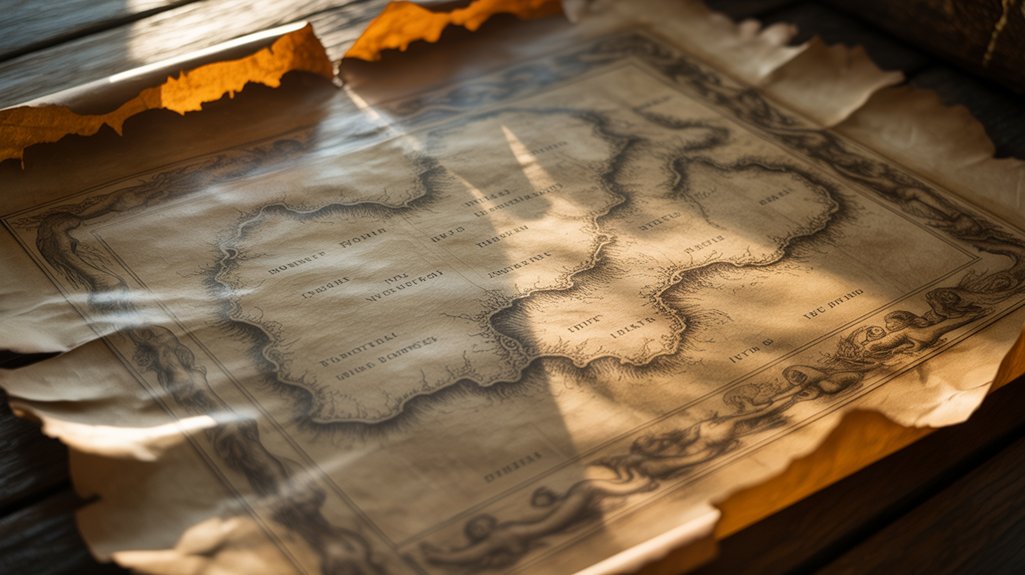
Across the hemispheres and through the millennia, water spirits have emerged from humanity’s oldest settlements wherever rivers carved their channels and seas lapped at primordial shores.
You’ll discover these entities weren’t born from singular imagination but arose independently across continents, their cultural variations revealing profound geographic influences that shaped each civilization’s aquatic mythos.
The distribution patterns illuminate humanity’s relationship with water itself:
- Mediterranean nymphs dwelling in Grecian springs since 1500 BCE, their origins traced to Minoan worship
- Slavic rusalki haunting northern waterways from the Dnieper to the Volga’s eldritch depths
- Germanic undines emerging from Rhine tributaries and North Sea coastal folklore
- Celtic selkies inhabiting Atlantic shores where land meets chimeric ocean domains
- Japanese mizuchi coiling through sacred rivers of the archipelago
These separate manifestations weren’t mere coincidence.
Ancient peoples independently recognized something liminal in water’s nature—something that demanded personification, reverence, and eternal watchfulness.
Each tradition’s mythical creatures carried distinctive features and symbolism that reflected their culture’s unique relationship with aquatic environments and the spiritual forces believed to inhabit them.
Physical Descriptions and Supernatural Abilities
While ancient texts speak of water spirits in metaphor and myth, their described physical forms reveal consistent patterns that transcend cultural boundaries—patterns suggesting either collective human psychology or something more unsettling dwelling beneath the surface.
You’ll find their physical characteristics share remarkable consistency: luminescent skin suggesting moonlight on water, hair flowing like rivulets, eyes reflecting depths unfathomable. Rusalka possess that eldritch quality—beautiful yet corpse-pale, their limbs elongated beyond natural proportion.
Greek nymphs manifest less chimeric features, appearing almost mortal save for their preternatural grace. Undines shift between forms entirely, embodying water itself.
Their mystical powers align with their element: drowning unwary travelers through enchantment, controlling tides and currents, breathing life into springs. Some command weather; others read futures in rippling surfaces.
The Slavic rusalka’s tickling torture proves fatal. Germanic undines grant immortality through marriage, binding mortal souls to liquid eternity. Each tradition preserves knowledge you’d do well to respect—these aren’t mere folktales.
Interactions With Mortals: Seduction, Protection, and Revenge
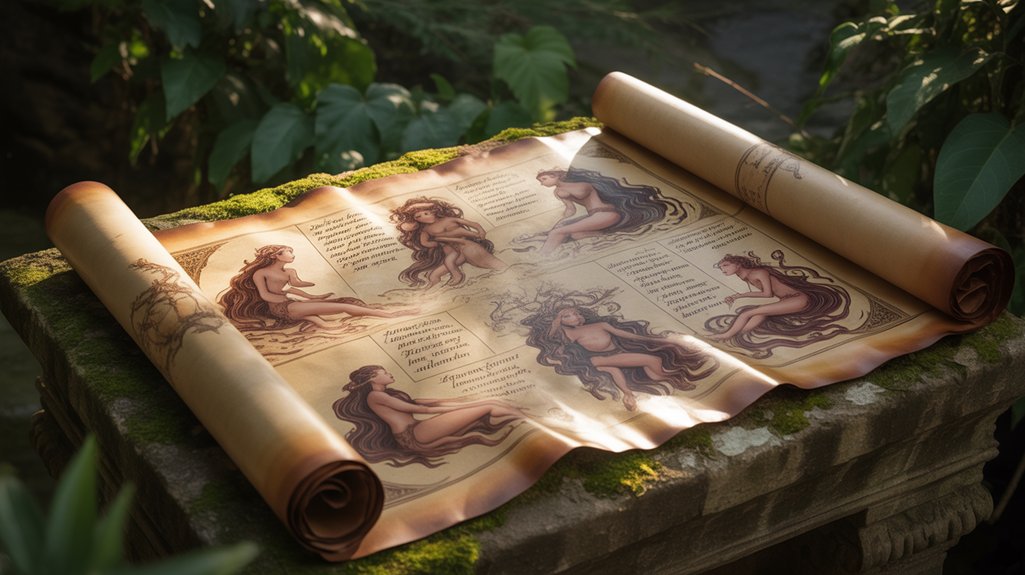
These powers never exist in isolation—water spirits wield their supernatural gifts specifically to engage with humankind, forging relationships that span the spectrum from beneficent guardianship to vengeful destruction.
You’ll find water spirit seduction operates as mythology’s most potent metaphor for nature’s dual essence, simultaneously nurturing and annihilating those who dare approach sacred boundaries.
Transformative interactions manifest through patterns:
- Enchanting allure draws mortals to moonlit shores, where rusalki’s songs promise ecstasy before drowning
- Spiritual guardianship protects fishermen who offer proper tribute, granting safe passage through treacherous waters
- Revengeful spirits emerge when humans pollute springs or betray romantic vows
- Mortal protection extends to children and innocents, particularly in Germanic undine traditions
- Vengeful encounters punish those who witness sacred bathing rituals uninvited
These mythological relationships reveal humanity’s eternal struggle: respecting eldritch forces while seeking their favor.
The chimeric nature of such beings—simultaneously lover, guardian, destroyer—demands you acknowledge nature’s sovereignty.
Cross these thresholds carefully.
Water Spirits as Explanations for Natural Phenomena
Before scientific inquiry illuminated hydrological cycles and meteorological patterns, ancient civilizations encoded their observations of water’s mercurial behavior into narratives of divine temperament and supernatural agency.
You’ll discover that sudden drownings became rusalka’s vengeful embrace, while treacherous currents altered into undines guarding their domains. Water myths provided frameworks for understanding the eldritch forces governing survival itself.
These elemental connections weren’t mere superstition. They represented sophisticated observations cloaked in metaphor.
When Greek communities witnessed whirlpools forming near rocky outcrops, they attributed them to nereids dancing beneath the surface.
Medieval Europeans explained flash floods through narratives of angered nixies releasing their fury upon transgressive mortals.
The Slavic peoples understood spring’s dangerous ice breaks as rusalka emerging from winter imprisonment, their resurrection explaining seasonal alteration through supernatural agency.
You’re witnessing humanity’s first ecological models—attempts to predict, explain, and respect water’s power through personification that demanded reverence, sacrifice, and cautious negotiation with forces beyond mortal control.
Artistic and Literary Representations Through the Centuries
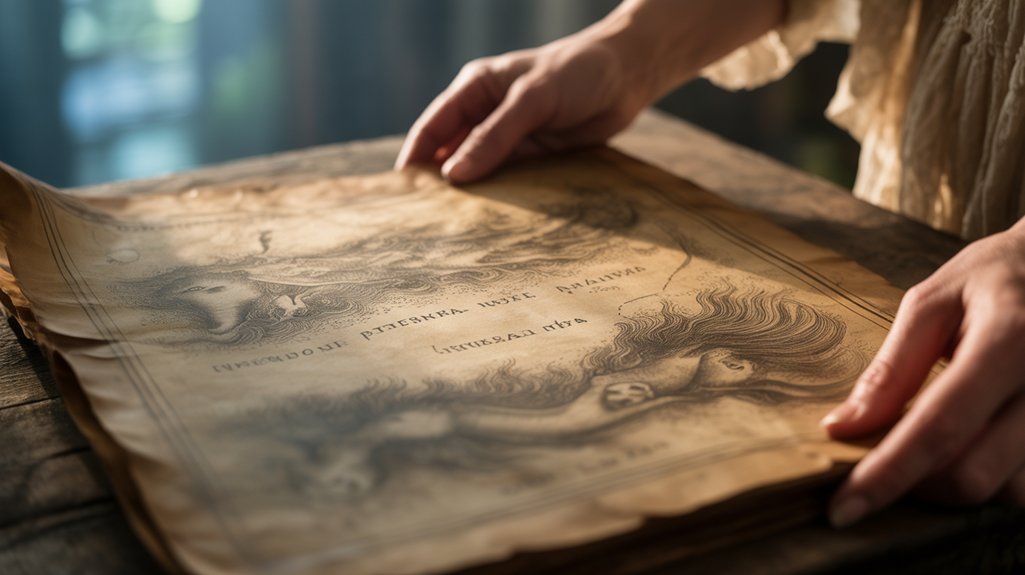
As brush met parchment and chisel struck marble across millennia, water spirits underwent metamorphosis from oral tradition into tangible aesthetic form—their fluid essences captured in pigment, verse, and stone.
You’ll discover artistic symbolism embedded within Renaissance fountains, where marble naiads embody humanity’s eternal dance with aqueous territories.
Literary motifs emerge through German Romanticism’s *Undine* (1811), establishing templates for subsequent narratives exploring liminal identities between mortal and eledritch domains.
These representations grant you liberation from temporal constraints:
Art transcends chronology—each brushstroke and carved form delivers ancestral encounters with water spirits directly into your present consciousness.
- Pre-Raphaelite paintings depicting rusalki with haunting, luminescent gazes
- Slavic folk songs preserving chimeric maiden-spirits through melodic transmission
- Medieval illuminated manuscripts featuring ornate water nymph marginalia
- Symbolist poetry channeling undine consciousness through sensory immersion
- Art Nouveau ceramics capturing serpentine movement of aquatic entities
Through each medium, you witness alteration—ancient reverence translated into aesthetic language, granting contemporary access to primordial wisdom.
These creative vessels preserve what rational discourse can’t contain.
Modern Interpretations and Contemporary Relevance
Contemporary consciousness encounters water spirits through fractured lenses—ecological crisis alters ancient nymphs into symbols of threatened waterways, while digital media resurrects folkloric forms within anime, cinema, and immersive gaming environments. You’ll find modern adaptations changing rusalka from vengeful drowning maidens into environmental symbolism, their eldritch calls now warnings against industrial pollution, their chimeric forms embodying rivers choked with waste.
| Medium | Representation | Cultural Function |
|---|---|---|
| Environmental Activism | Nymphs as watershed guardians | Consciousness-raising for aquatic preservation |
| Film & Television | Rusalka in horror/fantasy genres | Exploration of feminine rage, ecological revenge |
| Video Games | Interactive undine encounters | Player agency in mythological narratives |
| Contemporary Literature | Reimagined water spirits | Post-colonial reclamation of indigenous water deities |
| Visual Arts | Installation pieces featuring liminal aquatic beings | Commentary on climate change, habitat destruction |
These modern interpretations maintain reverence for ancestral wisdom while addressing humanity’s fractured relationship with water, altering ancient folklore into urgent contemporary mythology.
Frequently Asked Questions
Are There Male Water Spirits or Are They All Female?
You’ll discover male water spirits inhabiting rivers and oceans across cultures, though they’re less prominent than their female counterparts.
Germanic Nix, Slavic Vodyanoy, Greek Potamoi, Japanese Kappa—all masculine entities dwelling in liminal depths.
These beings challenged rigid gender roles; some shape-shifted between forms.
Ancient societies, steeped in patriarchal structures yet acknowledging fluid spiritual dimensions, conceived masculine water guardians as protectors, tricksters, dangerous lovers.
The feminine dominance reflects historical associations between water, fertility, creation—yet you’ll find masculine spirits lurking beneath surfaces, eldritch and untamed.
How Do Water Spirits Differ From Mermaids and Sirens?
You’ll find water spirit types fundamentally differ in their elemental essence—they’re純粋な manifestations of aquatic forces themselves, not chimeric flesh-and-blood beings.
Mermaids possess corporeal forms: scaled tails, tangible bodies. Sirens, those eldritch Greco-Roman seductresses, inhabit physical avian or piscine forms.
But nymphs, rusalki, undines? They’re consciousness woven from water itself. Their mythical origins reveal them as intermediaries between mortal and divine domains, guardians of sacred springs.
Shapeshifters bound to specific waters, never wandering freely through ocean depths like their hybrid counterparts.
What Offerings or Rituals Were Used to Appease Water Spirits?
You’d offer sacred offerings at twilight—flowers, bread, honey, coins cast into liminal waters where mortals meet the eldritch.
Purification rituals demanded your reverence: ablutions at dawn, libations poured clockwise, white linen garments.
Slavic traditions required you to weave wreaths for rusalki during Rusalka Week, while Greek suppliants burned incense at sacred springs.
You’d whisper prayers, never commands. The numinous demands humility, not dominion—these ancient protocols acknowledging forces beyond human sovereignty, beyond control.
Can Water Spirits Permanently Leave Their Waters or Transform Into Humans?
Like mist ascending from morning waters, you’ll find these entities bound by eldritch laws of water alteration—yet capable of temporary transcendence.
Rusalka, those Slavic drowned maidens, could walk forests during Rusal’naia Week. Undines gained souls through marriage. True permanence? Rarely achieved.
The spirit domains hold them fast, tethered by ancient contracts, geographic origins, elemental essence itself.
Freedom existed in liminal moments—dusk, solstices, ritual transgression—when boundaries blurred, allowing chimeric passage between worlds.
Do Any Major Religions Incorporate Water Spirits Into Their Beliefs?
You’ll find water deities woven throughout major faiths—Christianity’s baptismal rivers carry profound spiritual symbolism, while Hinduism reveres Ganga as goddess incarnate.
Islam honors sacred wells; Shinto’s kami inhabit every stream and waterfall.
Even Buddhism embraces nāgas, serpentine water spirits dwelling in liminal depths.
These aren’t mere folklore—they’re living theological elements.
Ancient currents flow through modern practice, eldritch and undeniable, granting you access to wisdom that transcends institutional boundaries.
Conclusion
You’ve journeyed through aqueous domains where naiads once blessed Hellenic springs, where rusalki haunted Slavic riverbanks with their eldritch songs, where undines embodied alchemical wisdom in Renaissance treatises. These water spirits persist: surveys reveal 43% of coastal communities worldwide still maintain active folk traditions involving water deities. Their chimeric forms continue emerging in literature, art, contemporary environmental movements—ancient voices rippling through modern consciousness, reminding you that humanity’s relationship with water remains profoundly, irrevocably sacred.

